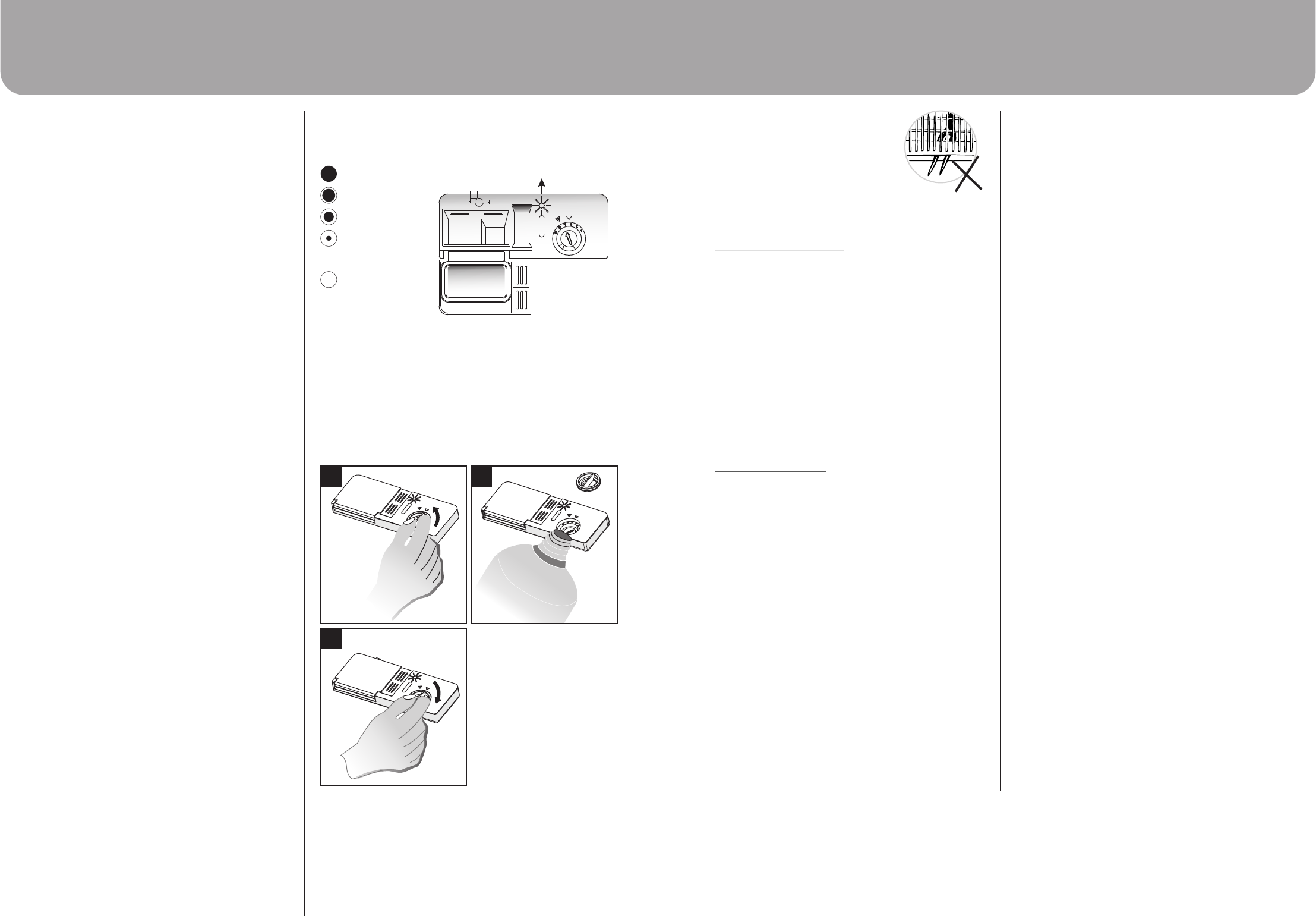
Using Your Dishwasher
Page 12 Page 17
Using Your Dishwasher
As the rinse aid diminishes, the size of the black dot
on the rinse aid level indicator changes, as illustrated
below.
BEFORE STARTING THE DISHWASHER
The following things should be checked before
starting the dishwasher.
1. That the dishwasher is level and fixed properly.
2. That the inlet valve is open .
3. That there is no leakage at the connections of the
conducts.
4. The wires are tightly connected and the power is
switched on.
5. That the inlet and drain hoses are not knotted or
kinked.
6. All packing materials should be taken out of the
dishwasher.
PRIOR TO USING FOR THE FIRST TIME
Before using your dishwasher for the first time:
Fill the Rinse Aid Dispenser
The rinse aid is released during the final rinse to
prevent water from forming droplets on your dishes,
which can leave spots and streaks. It also improves
drying by allowing water to roll off the dishes. Your
dishwasher is designed to use liquid rinse aids. The
rinse aid dispenser is located inside the door next to
the detergent dispenser. To fill the dispenser, open the
cap and pour the rinse aid into the dispenser until the
level indicator turns completely black. The volume of
the rinse aid container is about 140ml.
Function of the Rinse Aid
Rinse aid is automatically added during the last rinse,
ensuring thorough rinsing, and spot and streak free
drying.
WARNING!
Only use branded rinse aid for dishwasher. Never fill
the rinse aid dispenser with any other substances
(e.g. Dishwasher cleaning agent, liquid detergent).
This would damage the appliance.
When to refill the Rinse Aid Dispenser
If there is no rinse-aid warning light in the control
panel, you can judge the amount of rinse-aid by the
color of the optical level indicator "C" located next to
the cap. When the rinse-aid container is full, the whole
indicator will be dark. As the rinse-aid diminishes, the
size of the dark dot decreases. You should never let
the rinse aid get below 1/4 full.
Full
3/4 Full
1/2 Full
1/4 Full
(Should refill to
eliminate spotting)
Empty
How to fill the Rinse Aid Dispenser
1. To open the dispenser, turn the cap to the "open"
(left) arrow and lift it out.
2. Pour the rinse aid into the dispenser, being careful
not to overfill.
3. Replace the cap by inserting it aligned with "open"
arrow and turning it to the closed (right) arrow.
Be careful not to overfill the dispenser, because this
could cause over sudsing. Wipe away any spills with a
damp cloth. Don't forget to replace the cap before you
close dishwasher door.
ATTENTION! Clean up any rinse aid split during filling
with an absorbent cloth to avoid excess foaming
during the next wash.
Suitability of items for use in your Dishwasher
Ÿ
Ÿ
Ÿ
Ÿ
Ÿ
Ÿ
Ÿ
Ÿ
Ÿ
NOT SUITABLE FOR USE
Cutlery with wooden, horn china or m o t h e r - o f -
pearl handles.
Plastic items that are not heat resistant.
Older cutlery with glued parts that are not
temperature resistant.
Bonded cutlery items or dishes.
Pewter or copper items.
Crystal glass.
Steel items subject to rusting.
Wooden platters.
Items made from synthetic fibres.
LIMITED SUITABILITY
Some types of glasses can become dull after a
Ÿ
large number of washes.
Silver and aluminum parts have a tendency to
Ÿ
discolour during washing.
Glazed patterns may fade if machine washed
Ÿ
frequently.
NOTE:
Do not put in items that are dirty with cigarette ash,
Ÿ
candle wax, lacquer or paint.
If you buy new dishes please make sure that they
Ÿ
are suitable for dishwashers.
Please do not overload your dishwasher. Do not
Ÿ
use dishes that are not suitable for dishwashers.
This is important for good results and for
reasonable energy consumption.
Before loading the dishes, you should:
Remove large food particles.
Ÿ
Soften remnants of burnt food in pans.
Ÿ
When loading the dishes and cutlery, please note:
Dishes and cutlery must not impede the rotation of
Ÿ
the spray arms.
Load hollow items such as cups, glasses, pans etc.
Ÿ
with the opening downwards so that water cannot
collect in the container or a deep base.
Dishes and items of cutlery must not lie inside one
Ÿ
another, or cover each other.
To avoid damage to glasses, they must not touch.
Ÿ
Load large items which are most difficult to clean
Ÿ
into the lower rack.
The upper rack is designed to hold more delicate
Ÿ
and lighter dishware such as glasses, coffee and
tea cups.
Long bladed knives stored in an upright position are
a potential hazard!
Long and/or sharp items of cutlery such as carving
knives must be positioned horizontally in the upper
basket.
Damage to glassware and other dishes
Possible Causes
Type of glass or manufacturing process. Chemical
Ÿ
composition of detergent.
Water temperature and duration of dishwasher
Ÿ
program.
Suggested remedy:
Use glassware or porcelain dishes that have been
Ÿ
marked dishwasher-proof by the manufacturer
Use a mild detergent that is described as kind of
Ÿ
dishes If necessary, seek further information from
detergent manufacturers.
Select a program with as low a temperature.
Ÿ
To prevent damage, take glass and cutlery out of
Ÿ
the dishwasher as soon as possible after the
program has ended. as possible after the program
has ended.
ATTENTION!
Ÿ
Ÿ
WARNING!
Ÿ
Ÿ
Do not let any item extend
through the bottom.
Always load sharp utensils with
the sharp point down!
C (Rinse-Aid indicator)
MIN
MA
X
1 2
3
